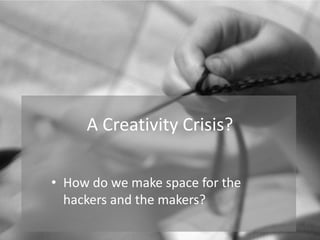Breaking traditions 2013
- 1. A Creativity Crisis? âĒ How do we make space for the hackers and the makers?
- 3. Creativity is not about creating âsomething out of nothingââĶ Creativity encodes, selects, re- combines synthesises already existing facts, ideas, facilities, skills Arthur Koestler (1964) The Act of Creation
- 4. We are educating young people for a future not yet invented
- 5. âĒ But we do know that it will be a future that demands creative approaches to life, work and community
- 6. 20th Century 21st Century Worker Participant Consumer Innovator Charles Leadbetter
- 7. The future is open for us to act on it, but not for us to control - Edmund Phelps
- 8. Are you a creative person?
- 9. We used to think creativity was given to just a special few We were mostly afraid of them
- 10. Elizabeth Gilbert â creativity is a kind of divine intervention â arrived at by hard work
- 11. Creativity is not just an economic imperative today â itâs a personal one
- 12. And a social one
- 13. Knowledge is a commodity The world does not care about what you know
- 14. The world cares about what you can do with what you know
- 15. The world does not ask, what knowledge you have? It asks what skills do you have? What can you do? Are you motivated? Tony Wagner â Creating Innovators
- 16. To be a Continuous learner / Active informed citizen: Collaboration Critical thinking / across networks â Agility / Problem solving leading by Adaptability influence Effective Oral / Accessing / Initiative / Written Analysing Entrepreneurship Communications Information Curiosity / Imagination
- 17. What does a creative person look like?
- 20. My Grandfather cut more turf in a day than any other man on Tonerâs bog Nicking and slicing neatly, heaving sods over his shoulder, going down and down. For the good turf. Digging
- 21. 70s oil shortages? Not a problem :)
- 22. Power outages?
- 23. Stove Starter Stove wonât light?
- 25. And heâs infected his grandchildrenâĶ
- 26. Just Do It Risk Taking Not hung Tenacious, up on Never give process up Do we educate these attributes out of young people?
- 27. âĒ PISA scores inversely correlated with innovation â Pam Moran / Ira Socol
- 28. Economic Requirements - skills in creativity, design, problem solving and innovation will be essential for high productivity âĒ Una Halligan, Chair, Expert Group on Future Skills Needs 2009
- 29. Our main brands
- 30. Lean Manufacturing â Flow Improve quality, Eliminate waste, Simplify Identify problems and empower local users to solve using the Scientific Method (Lean Six Sigma) Flatten hierarchies Manage Risk
- 31. What our students will make and use â hasnât been invented yet Because our students will invent them
- 32. Resilience and ability to weather change
- 33. The font of creativity is vulnerability There is no innovation or creativity â without failure
- 34. Creativity in schools 1:04 3:55
- 38. Schools are hugely powerful Last community resource âĒ Keri Facer
- 39. Do we protect children too much? Can civic society and school work together to build new futures? School as centre of local innovation? âĒ Keri Facer
- 40. Coder Dojo Apps for Good Young Rewired State
- 41. CoderDojo â notice where the parent is (left) and where the children are (leading the room)
- 42. Apps for Good
- 44. Academia Online Education â NUI Galway MOOCs â Sligo IT Student as Producer â Lincoln University Bridge to Learn â Trinity #Edchatie
- 48. Carl Rogers âSaw himself as a facilitator - one who created the environment for engagement. âĒActive Listening âĒCreating a safe space There were 'ways of being' with others that foster âĒ Realness in the facilitator of exploration and encounterâ learning Smith (1999) âĒ Prizing, acceptance, trust âĒ Empathetic understanding Further reading: Joe McCarthy Donald Clark
- 50. Mentors Is there a teacher or mentor whoâs made a difference â 2/3rds said yes Many of these mentor teachers were outliers
- 51. What can each one of us do? Nurture our own creativity We have to be innovators, model, take risks, make mistakes, learn from them, work collaboratively Where am I modelling play, passion, purpose? Connect with others doing the same
- 52. Create safe spaces Model Creativity Make connections with students & outside our institution Get out of the way
Editor's Notes
- #8: http://www.flickr.com/photos/colmsurf/319960285/http://www.sligotourism.ie/wordpress/wp-content/uploads/billabong.jpg
- #14: http://www.flickr.com/photos/prizepony/6138727377/in/photostream/
- #15: http://www.flickr.com/photos/prizepony/6138737019/
- #18: http://www.flickr.com/photos/75166820@N00/137719056/sizes/l/in/photostream/
- #22: http://www.flickr.com/photos/12583940@N00/246969326/sizes/z/in/photostream/in_2_the_frayhttp://www.flickr.com/photos/jvk/73545520/sizes/z/in/pool-71603202@N00/
- #23: http://www.flickr.com/photos/58847482@N03/5846968269/sizes/l/in/photostream/http://www.flickr.com/photos/cramocommunications/6537516581/sizes/l/in/photostream/
- #24: http://www.flickr.com/photos/jvk/6581618/sizes/l/in/photostream/http://www.flickr.com/photos/mogrify/3790003872/sizes/l/in/photostream/
- #33: Photo by By etutoriahttp://www.flickr.com/photos/etutoria/8368017807/in/photostream
- #40: http://www.learningwithoutfrontiers.com/2012/02/keri-facer-learning-futures/





















































